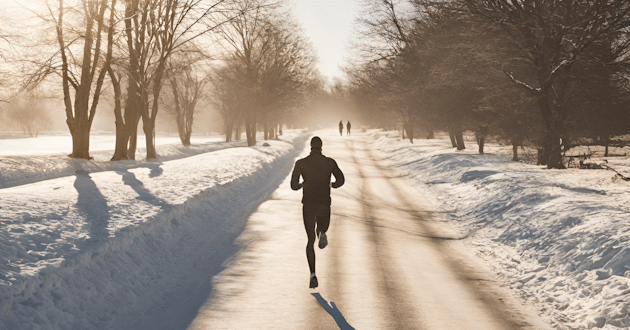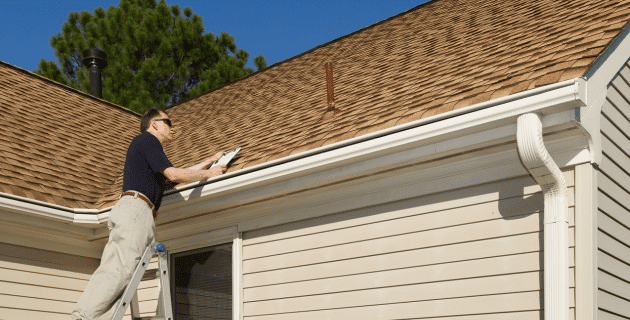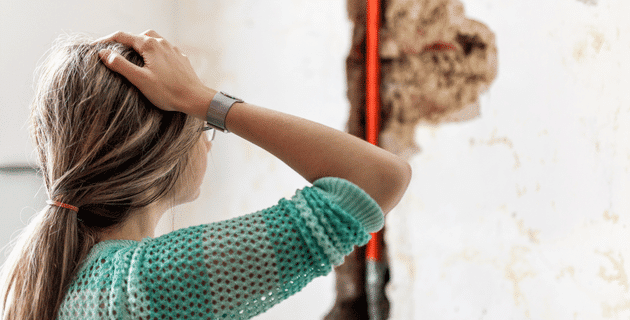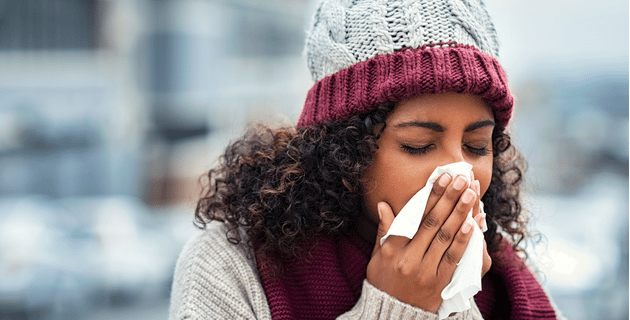
by California Casualty | Health, Helpful Tips |
It’s easy to exercise in the spring and fall when the weather beckons you to come outside. It may take a bit more inspiration in the winter, but it’s worth it.
Getting outside in cold weather connects you with nature, lifts your mood, and gives you a beneficial dose of sunlight/vitamin D. It also boosts your immunity during cold and flu season. With no heat and humidity, you might even be inspired to work out longer.
However, there is a way to do it safely. Follow these winter fitness tips for the basics of exercising in cold weather.
Choose the right fabrics.
When you’re wet, you lose body heat and that makes you feel cold. The colder you are, the less likely you’ll want to work out. In addition, cold can put you at risk for frostbite or hypothermia. Avoid active wear made from cotton, which holds in moisture from sweat and rain/snow. Instead choose synthetic fibers like polyester, nylon, and polypropylene. They dry quickly and wick away moisture.
Layer your clothes.
Use layers to trap warm air next to your body. Start with a thin base layer of synthetic fabric, which will keep sweat away from your skin. Then add a middle layer such as a fleece. Your outer layer should be either a lightweight nylon windbreaker or if it’s cold, a heavyweight waterproof jacket. As you exercise and get warmer, remove a layer, and tie it around your waist. That will help you from getting hot and sweaty which can lead to feeling damp and cold.
Pro Tip: Wear bright colors. Visibility is more limited in winter from rain, snow, fog, or dark skies. Be seen by the people and vehicles in your immediate area.
Protect your hands and feet.
In cold weather, blood is circulated to the core of your body, leaving less heat funneled to your extremities – your fingers, ears, nose, and toes. That means these areas are less warm. To counter that effect, wear a hat or headband, gloves or mittens, and thick socks. Choose materials like wool or synthetic as cotton could get wet. If your toes get cold, consider your shoes. Running shoes are designed to let heat escape. You can buy shoe covers at skiing and hiking stores. There also are specialty running sneakers designed for winter.
Protect your skin.
Winter isn’t just cold; it’s dry, and that can affect your skin. Apply moisturizer or lotion regularly. When you’re going to be outdoors, also apply sunscreen. SPF rays can damage your skin even when it’s cloudy. Snow reflects up to 80 percent of UV rays, so you get doubly exposed. UV rays also increase with elevation. Every 1,000 meters (3,281 ft.) in altitude, UV radiation increases by 10 percent.
Make sure you have traction.
When you’re exercising on icy surfaces, it’s easy to slip. That can lead to injury. Make sure that you have footwear with good traction and stay on plowed surfaces or salted ones. Take care to remove ice from your own property. If you will be primarily on the ice and snow, consider adding snow or ice spikes to your footwear. Just note that while those spikes help on icy surfaces, they can affect your balance on dry ones.
Take the time to warm up.
It’s especially important to warm up for an exercise routine in cold weather. You want to
Increase your blood flow and temperature so you’re not at risk for sprains and strains. A good analogy is what happens when you stretch a cold rubber band. It can snap more easily than a warm one. That’s what could happen to your muscles. For your warm-up, choose low intensity moves that are like those in your workout. Lunges, squats, and arm swings, for example, are good for runners.
Pro Tip: Head into the wind at the beginning of your workout. When you’re on your way back and feeling sweaty, you won’t have to fight the wind chill as much. That will help keep you warmer.
Pay attention to your breathing.
Cold weather causes your airway passages to narrow. That’s why it can hurt to breathe when you’re exercising in cold weather. Breathing through your nose can help but isn’t always possible when you’re moving intensely. Try wrapping a scarf or some thin fabric around your mouth. It will help keep in the humidity.
Hydrate.
You may not feel as thirsty during cold weather workouts. However, you’re still losing fluids. Dehydration carries risks, including headaches and a drop in energy. Sip water while you’re exercising. If you’re going to be exercising for more than 90 minutes, choose a sports drink like Gatorade.
Cool down. Change clothes.
You can get chilled fast after a workout. Take the time to cool down, which helps reduce later muscle soreness. It also helps your heart transition from an exercise pace to a normal rhythm. Then get out of your damp clothes. Take a warm shower and change into clean, dry clothes.
Avoid severe weather.
While cold weather workouts are beneficial, there’s a limit to when you should exercise outside. Avoid the extreme cold. Don’t exercise outdoors during winter storms. Prolonged exposure to the cold can cause frostbite and hypothermia. The cold also can put a strain on your heart. If you have a chronic health condition such as asthma or a heart problem, talk to your doctor about whether cold weather exercise is right for you.
Know the signs of hypothermia.
Finally, be aware of the signs of hypothermia. That’s when your body temperature drops too low and affects other systems in your body. If you experience any of these signs, get medical help right away.
- Shivering
- Lack of coordination
- Slow reactions
- Slurred speech
- Mental confusion
- Exhaustion or sleepiness
This article is furnished by California Casualty, providing auto and home insurance to educators, law enforcement officers, firefighters, and nurses. Get a quote at 1.866.704.8614 or www.calcas.com.

by California Casualty | Educators, Firefighters, Health, Nurses, Peace Officers |
If the winter months get you down, you’re not alone. Seasonal Affective Disorder (SAD) affects millions of people, and it’s more than just the winter blues. It can affect your mental and physical health.
Here’s what you need to know about SAD, including how to recognize signs and symptoms, some available treatments, and how to help those around you if you think they suffer from this condition.
What is SAD?
Seasonal Affective Disorder is a type of depression. It is more than feeling sad or unhappy, and it is not a condition that can be wished away. Symptoms start in the late fall and continue into the winter months. They are most severe during December, January, and February. Generally, SAD resolves itself during the light-filled days of spring. (There also is a form of summer SAD, thought to be caused by the heat, humidity, and allergies. Summer SAD is much less common.) SAD usually starts in adulthood. It is rare among people who are under age 20. It is more common among women than men.
What causes SAD?
The exact cause is not known, but it is thought that SAD is linked to reduced exposure to sunlight. Light stimulates the hormone, serotonin, in our brain which makes us feel happy. Increased darkness on the other hand prompts the brain to make more melatonin, causing sleepiness and reduced energy.
What are the signs of SAD?
SAD can affect how you feel, think, and behave. The symptoms are persistent and can be severe. While not every person experiences all the symptoms, here are some common ones for winter SAD.
- Losing interest in activities: If the activities that usually interest you lose their appeal, that’s a symptom of a low mood or depression.
- Low energy and sluggishness: You may find it difficult to muster the energy to do the most basic tasks. You might experience extreme fatigue.
- Sleeping too much: You find yourself sleeping more than usual, and you have difficulty waking up. You may experience daytime drowsiness.
- Appetite changes: You crave the mood and energy boosting comfort of carbs. However, overloading on carbs can lead to weight gain.
- Difficulty concentrating: You may be unable to focus and have trouble thinking clearly.
- Negative thinking: You may feel hopeless, worthless, or even suicidal. You might be anxious and irritable.
What are options for treatment?
Without treatment, SAD can last months. However, most people who seek help can see improvement in a matter of weeks. The symptoms of SAD may look like other mental health conditions, so it’s important to get a diagnosis. A doctor or mental health professional can diagnose SAD and offer options for treatment. Treatments may include:
- Light therapy: This involves sitting in front of a special light in a lightbox or panel for a specific amount of time each day.
- Sunlight exposure: Spending more time outside during daylight hours can help. Consider a daily walk or outdoor exercise.
- Psychotherapy: Talk therapy can help you to understand SAD and manage its symptoms from anxiety to depression.
- Medications: ln some cases, antidepressants may be prescribed to correct the chemical imbalance caused by SAD.
Here are some ways to help prevent SAD.
You can take steps to prepare for winter SAD, which may help to reduce its effects.
- It may be tempting to go into hibernation mode when it starts to become dark early. However, that can perpetuate the feelings of depression. Instead, plan activities to stay social. This will help to boost your mood.
- Exercise regularly. If you can exercise in the sunlight, that’s a double boost.
- Eat a healthy balanced diet. If you’re tempted by carbs for a quick energy boost, go for complex carbohydrates instead. For example, choose whole grain breads and fruits over sweets and chips.
- Maintain a consistent sleep routine. Avoid excessive amounts of caffeine and alcohol, especially before bed.
Finally, seek professional help if your symptoms persist. SAD is treatable, and fortunately, does not last forever.
This article is furnished by California Casualty, providing auto and home insurance to educators, law enforcement officers, firefighters, and nurses. Get a quote at 1.866.704.8614 or www.calcas.com.

by California Casualty | Finances, Homeowners Insurance Info |
A home inspection is an important part of buying and selling a home. In fact, it can make or break a sale. That’s why the questions you ask your home inspector are so important.
We’ve compiled a list of questions so you can get the most out of your home inspection. Keep this list handy and share it with anyone who is buying or selling a home.
First, a quick explanation about home inspections vs. home appraisals…
It’s easy to confuse home inspections with home appraisals. The processes are similar.
- A home inspector looks at the condition of a home and its systems, from electrical and plumbing to heating and ventilation, foundation, and more. He or she points out any areas of major concern. These are repairs that can be negotiated before the home is sold. Otherwise, the home inspection report is a “to do” list for the future homeowner.
- A home appraiser’s job is to estimate the value of the home. He or she looks at the condition of the house and notes any upgrades. The appraiser compares the home to similar ones in the area. Then, they establish a value and share it with the lender. That way the loan amount does not exceed the value of the home.
Most lenders require home inspections for loan approval. If you’re buying a home, the home inspection helps you know exactly what you’re getting. If you’re selling a home, you may consider doing a pre-listing home inspection. That can flag any major issues that could cause buyers to withdraw their offer.
Here’s what to ask your home inspector before and during the inspection.
What are your credentials?
Maybe your realtor referred you to a home inspector. Maybe you found him or her through Google, a Facebook neighbors’ group, or old-fashioned word of mouth. Either way, you want to make sure your home inspector has the right training and experience.
- How long have you been doing this?
- Do you belong to a state or national association?
- Do you participate in any continuing education?
- Are you bonded and insured? (If anything happens to the property during an inspection, the bond will protect the homeowner.)
- May I get references from satisfied clients?
- May I get a copy of your inspector’s license and insurance?
What are the payment details?
Home inspection is a service that is paid for by the person requesting the inspection. It could be the prospective homebuyer, or it could be the seller who wants to make sure everything is in order before placing the home on the market. Home inspection costs vary, depending on the region, size, and age of the house.
- What will the home inspection cost?
- When do you need payment? (Most inspectors will need payment immediately after the inspection.)
- What type of payment do you prefer?
What does the report look like?
You want to know what you’re purchasing ahead of time, and an easy way to do that is to see a sample inspection report. You’ll be able to see your inspector’s reporting style, whether there are pictures, etc.
- Can I see a sample report?
- Do you provide digital photos?
- How long after the inspection do you provide the report?
- How do you send it?
What does the inspection cover?
A home inspection should comply with standard practice and meet all requirements in your state. If you live in a condo, your inspector does not have to inspect the common spaces, roof, or exterior walls. For single family homes and townhomes, you can expect the full home to be reviewed. However, this may not include radon or mold, so double check if you need additional inspections for those hazards.
- Do you walk the roof? (It’s better if your inspector does. Some just use binoculars to eyeball any roof damage.)
- Do you do sewer line or septic tank inspections?
- Do you test for radon or mold?
- Do you test for lead (for homes built before 1978)?
- Do you test for carbon monoxide or check the smoke detectors?
- What does the inspection not cover?
May I attend?
You should be allowed to attend your home inspection, and it’s a good idea. (It’s also a red flag if your inspector says you are not allowed. Consider getting another inspector.) It takes about 2-3 hours for a typical single family home inspection, so be sure to allocate enough time. Come prepared with a list of questions. This is a great learning experience about your new home.
- Where is the main water shutoff?
- Where is the main electrical breaker?
- What is the age of the home’s systems? The roof?
- What is the routine maintenance needed for each of the home’s systems?
- What kind of pipes does the home’s plumbing system have (e.g. copper, CPVC water piping or polybutylene)? Polybutylene is defective water piping that is no longer being made.
- Are there any ungrounded outlets? These can become a fire hazard or short-circuit your appliances.
- Is the home well insulated? This will impact your energy bill.
- Does the home appear to be a flip (and therefore lower quality materials used in the renovation)?
Pro Tip: Verify that all permits have been pulled by the city or county for any renovations to the home. Failure to do so can tip you off that there were corners cut.
What should I do about the problems identified?
If you’re the buyer, you can use the problems as a negotiating point with the seller. If the problems are too costly, or living conditions are unsafe, you could walk away from the sale. While some states and associations forbid an inspector from performing repairs, you can ask your home inspector for guidance.
- Can you recommend a professional for this repair?
- What would you fix first if this were your home?
- Will you answer questions after the inspection?
- Do you perform re-inspections of a home to make sure everything is fixed? Not all inspectors do this due to liability issues.
With a successful inspection behind you, you’re ready to take the next step as a new homeowner. Protect your new home with the right insurance. Looking for a quote? Call us today.
This article is furnished by California Casualty, providing auto and home insurance to educators, law enforcement officers, firefighters, and nurses. Get a quote at 1.866.704.8614 or www.calcas.com

by California Casualty | Homeowners Insurance Info |
We all know the dreaded drip, drip, drip of a water leak. It’s the sound of a potentially expensive repair or at minimum, an annoying cleanup. Either way, you want to be prepared when it happens. Knowing what your homeowner’s insurance covers in terms of plumbing and pipe leaks is the first step.
In general, sudden plumbing issues are typically covered by insurance but plumbing problems that occur over time due to lack of maintenance may not be. The policy may cover damage resulting from plumbing breakdowns, but it won’t cover the cost to repair the plumbing itself. Insurance is intended to help in emergencies, not a substitute for regular maintenance.
What Insurance (Probably) Does Not Cover
Most policies do not cover old plumbing and pipe leaks. If you’ve got a slow leak and you ignore it until it gets worse, that’s likely not covered by your homeowner’s policy. When you file a claim, your insurance company will send an adjuster. They will determine the cause of damage, and decide whether it qualifies for coverage. Here are general guidelines on what insurance probably does not cover.
-
- Normal wear-and-tear and lack of maintenance are not covered. If you neglect your plumbing and pipes, you essentially have voided your policy.
-
- Leaks that started small and have gotten progressively worse over a period of years are not covered. The time to address them was when they started.
-
- Pipes that freeze because you turned off the heat would be categorized under neglect. So, if you went away on a winter vacation, and failed to take the necessary steps to protect your pipes, the damage that results may not be covered under your policy.
-
- Mold may be excluded from your standard policy. However, you could purchase additional coverage.
-
- Water damage from any flooding is not covered unless you have a flood policy.
What Insurance (Probably) Covers
From certain plumbing issues to broken, burst, or frozen pipes, your homeowner’s policy probably covers the ensuing damage if you have taken reasonable care and performed continued maintenance. For example, coverage for freezing of a plumbing system only applies if you “maintain heat in the building; or shut off the water supply and drain all systems and appliances of water.”
Insurance pays to repair the pipes or plumbing in these cases. It also compensates you for covered items that are damaged by the leak. Coverage A (which includes the plumbing system) will cover the plumbing system if there is a fire, tornado, explosion, etc. The contract specifically excludes coverage for “wear and tear, deterioration and latent defect, inherent vice” – basically, the policy will not pay for the plumbing system or pipes for leaks, broken, etc. – that is the homeowner’s responsibility. If it is a covered loss, the insurance company pays for the ensuing damage, i.e. flooring, baseboards, drywall, and personal property.
Your insurer will likely send someone out to determine the cause of loss and inspect the damage. You will get reimbursed by your policy, minus your deductible (which is the amount that you chose to pay out-of-pocket before insurance kicks in).
There are four different parts of your homeowner’s policy that address damage caused by plumbing and pipe leaks:
-
- Dwelling coverage covers the structure of your home. This includes the roof, walls, and floorboards. However, if you have to remove a wall to see if there is a leak, that would not be covered. There are companies that will come out and complete a Leak Detection Report to determine where the water is coming from. If the loss is covered and over the deductible, your insurance will pay for the report.
-
- Personal property coverage protects your possessions that may be damaged. Coverage may apply if there is “an accidental discharge or overflow of water from within a plumbing system or household appliance.” Damage that occurs gradually due to a leaky pipe is generally not covered. Protected possessions include clothing, TVs, and furniture. There are dollar limits for certain items such as money, jewelry and firearms, so check with your insurer. (You could add an extra rider to cover those items.) For personal property coverage on a homeowner’s policy, you typically get 50 or 75% of Coverage A, the total amount of coverage for your home.
-
- Other structures coverage protects detached buildings, such as garages or guest houses, that may be damaged due to plumbing issues. The coverage limit for other structures is generally set at 10% of your home’s coverage limit. That means if your home is insured for $200,000, the coverage limit for your garage would be $20,000. For an additional premium, you can add an endorsement for additional coverage.
-
- Depending upon the extent of the damage, your house may not be livable. If that’s the case, you would need to stay somewhere else. You would be covered for any necessary increase in living expenses, such as lodging, food, and gas. Under Coverage D – Loss of Use, called “Additional Living Expense,” your policy will provide a flat percentage toward living costs, usually 30% of the Coverage A amount. Some states have time limits (e.g. 12 months) on when you can use that coverage. Plan to cover those additional expenses out-of-pocket.
How to Know if You Have a Leak
Taking the time to inspect your pipes and plumbing periodically can give you a heads-up that there could be a problem. The earlier you address it, the less costly it will be. Look for these signs that you may have a leak.
-
- Stains or discolorations on walls or ceilings
- Bulging or sagging spots on walls or ceilings
- A trickling sound when it is quiet, such as at night
- A musty smell, which can be a sign of moisture and mold growth
- Poor water pressure
- Rusted metal
- Peeling paint
- Steady increases in water bills
Finally, make sure your homeowner’s policy is up to date, and that it provides the coverage that you need. That will go a long way toward having peace of mind should you have a plumbing problem.
This article is furnished by California Casualty, providing auto and home insurance to educators, law enforcement officers, firefighters, and nurses. Get a quote at 1.866.704.8614 or www.calcas.com.

by California Casualty | Health |
It’s cold and flu season, and as a nurse, teacher, or parent, you’re likely surrounded by sniffling and coughing on the daily. So, at this point how can you keep yourself from getting sick?
Look no further; we’ve got you covered with the best tips to help keep you safe and sniffle-free this winter. Follow this guide to protect yourself and help boost your immune system.
Get quality sleep.
Our bodies do important work while we sleep. They repair cells and make proteins that fight infection. Getting enough sleep, and specifically, quality sleep is important to this process. We know it may be hard to get enough sleep when working 12-hour shifts as a nurse or as a parent of young children. Take the time to set yourself up for success with these tips.
-
- Set your thermostat to about 65 degrees for optimum sleeping temperature.
- Create a bedtime routine that does not include devices or television. Sometimes a warm shower or bath can help just prior to bed.
- Use a white noise machine or wear earplugs to soften distracting noise.
- Use blackout shades or curtains and/or wear an eye mask.
- Be consistent with bedtime routines for your children. If your children fall asleep within 15 to 30 minutes of going to bed, they are getting the right amount of sleep.
Pro tip: If you’re having trouble eliminating screens before bed, try wearing blue light-blocker glasses. They will help reduce the light that disturbs your circadian rhythm.
Eat immunity-boosting foods.
It’s easy to reach for prepared foods, microwave meals or vending machine finds. Resist the urge. Instead, fill your diet with the foods that help power your immune system.
-
- Choose fresh fruits and vegetables with nutrients such as vitamin C, vitamin E, and beta-carotene.
- Citrus fruits are great sources of vitamin C but so are red bell peppers.
- Blueberries are delicious as well as nutritious and can help boost your immunity.
- Broccoli and spinach are both superfoods with vitamins and antioxidants.
- Garlic and turmeric have immune-boosting properties. Ginger helps decrease inflammation.
Make sure to hydrate.
Water helps our bodies to function. Staying well hydrated helps our bodies circulate blood more easily, which allows our white blood cells to better fight off viruses. It also keeps the mucous membranes in our noses moist so they can catch viral invaders.
-
- Don’t wait until you’re thirsty to drink. By that point, you’re already slightly dehydrated.
- Choose a water bottle you love and bring it with you to work, errands, etc. Get into the habit of sipping throughout the day.
- If you’re bored with the taste of water, infuse it with lemon or cucumber to help encourage you to drink.
- Avoid other beverages so that you’ll drink more water. The caffeine in coffee and soda can dehydrate you, which has exactly the opposite effect of what your body needs.
- Green tea has only a small amount of caffeine, and tea has antioxidants. It’s a good choice if you’re looking for an alternative to coffee.
Reduce your stress.
When we’re stressed, our ability to fight off infection decreases. That’s why managing stress is so important.
-
- Take steps to avoid burnout. Slow down and give yourself breaks to protect your mental health.
- Try meditating, deep breathing, and other relaxation strategies.
- Incorporate exercise into your routine. Park farther away and walk to your destination. Take the stairs instead of the elevator. Plan a workout session that’s easy to fit into your schedule.
- Laugh more. Make time for the activities that you enjoy with the people who are important to you.
Follow healthy habits.
You can reduce your exposure to potential infections by taking the precautions that can make a difference.
-
- Continue proper handwashing habits. Wet your hands and then scrub them for at least 20 seconds with soap. That’s equivalent to humming Happy Birthday twice. Rinse with clean, running water. Use hand sanitizer when soap and water is not available.
- Reduce allergens in your home to improve indoor air quality.
- Keep your classroom at a comfortable temperature for learning.
- Don’t use handkerchiefs. Use disposable tissues and discard them when done.
- Don’t smoke. Drink alcohol in moderation. Both tobacco and alcohol can affect your body’s ability to fight infections.
- Keep up to date on your vaccinations
Do you have a way to stay healthy that’s not included in this blog? Share it with us in the comments.
This article is furnished by California Casualty, providing auto and home insurance to educators, law enforcement officers, firefighters, and nurses. Get a quote at 1.866.704.8614 or www.calcas.com.





